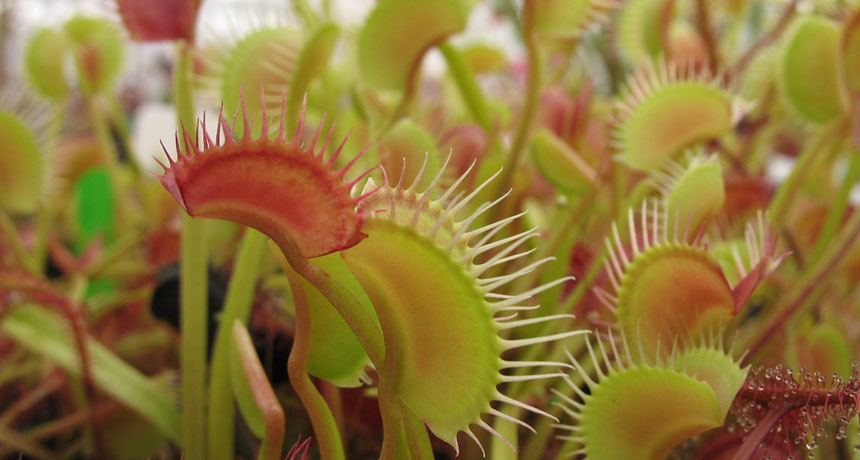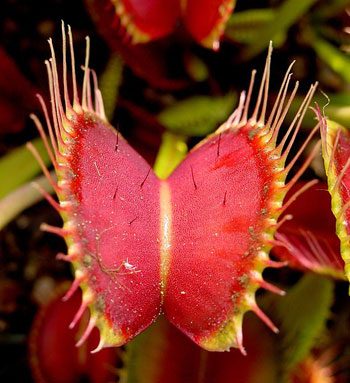Before eating, Venus flytraps must ‘count’
Plants track how many times an insect trips tiny hairs before turning on their digestive juices

After a Venus flytrap captures an insect inside the “trap” at the end of a stem, the struggle of its prey switches on the plant’s digestion.
Orin Zebest/Flickr (CC-BY 2.0)
Animals often eat plants. Some plants, though, flip that relationship on its head. Venus flytraps, for instance, catch — and consume — animals. To do that, a Venus flytrap has to count the number of times its prey moves, a new study finds. Two twitches spring the trap. Five rev up the plant’s digestion.
For Venus flytraps and any other plant, nitrogen is an important nutrient for growth. Most plants suck up nitrogen from the soil through their roots. Venus flytraps can do this, too. But nitrogen tends to be in short supply in their native wetlands in the southeastern United States. The nutrient in only available at certain times, such as after a fire. So the plants need another source. And they evolved a way to snap nitrogen right out of the air — in the form of its insect prey.
The Venus flytrap has a specialized leaf that acts as a trap. Inside this trap are hair-like triggers that tell the plant when to close the leaf. An insect walking across the leaf trap will bend one of those trigger hairs. That will cause cells to “fire,” or send signals, to nearby cells. This signaling is a form of electrical energy. It helps plant cells communicate in much the same way nerve cells work in people and other animals.

If the captured insect did not move, the trap would reopen in half a day, says Rainer Hedrich. He’s the biophysicist at the University of Würzburg in Germany who led the new study. (A biophysicist studies physical forces as they relate to living organisms.) But an insect will panic when the trap snaps shut. It starts to struggle against its enclosure. Those movements nudge the trigger hairs again and again — as many as 60 times per hour.
Enzymes are chemicals that this plant uses to digest the insect into nutrients it can absorb and use. But making digestive enzymes requires energy. That energy would be wasted if the plant had captured something it couldn’t eat. Hedrich’s group wondered how many triggers were needed before the plant started making those enzymes.
To find out, the scientists used the tip of a plastic pipette (specialized eye dropper) to nudge the trigger hairs. As expected, two nudges caused the trap to close. Nothing else seemed to happen after the third and fourth nudges. But after the fifth, glands lining the inside of the trap started making digestive enzymes.
This only happened when the hormone was released after the second touch, Hedrich says. When the researchers prevented the hormone from working, the glands did not make any enzymes. The hormone was needed to stimulate cells inside the glands to make and release digestive enzymes.
COUNT TO FIVE This video shows how the Venus flytrap captures and digests its prey. Sönke Scherzer/Univ. of Würzburg |
After five triggers, the plant also starts making molecules that help it absorb nutrients. More frequent triggers led the plant to make more of these molecules, the team found. That makes sense, Hedrich says, because bigger prey will nudge more trigger hairs. The increased activity lets the plant know it will have a big meal to consume.
The study was published on January 21 in Current Biology.
Scientists have known for centuries that Venus flytraps can count to two, says Andrej Pavlovic. The plant physiologist at Palacký University in the Czech Republic was not involved with the study. This new paper finds that a specific number of triggers causes plants to switch on genes (pieces of DNA), he says. And they do so to make molecules that are specific to digestion. It’s interesting to note that some of the molecules are also used in plant defense, he adds.
Power Words
(for more about Power Words, click here)
biophysics The study of physical forces as they relate to biological systems. People who work in this field are known as biophysicists.
cell The smallest structural and functional unit of an organism. Typically too small to see with the naked eye, it consists of watery fluid surrounded by a membrane or wall. Animals are made of anywhere from thousands to trillions of cells, depending on their size.
digest (noun: digestion) To break down food into simple compounds that the body can absorb and use for growth. Some sewage-treatment plants harness microbes to digest — or degrade — wastes so that the breakdown products can be recycled for use elsewhere in the environment.
DNA (short for deoxyribonucleic acid) A long, double-stranded and spiral-shaped molecule inside most living cells that carries genetic instructions. In all living things, from plants and animals to microbes, these instructions tell cells which molecules to make.
enzymes Molecules made by living things to speed up chemical reactions.
evolve (adj. evolving) To change gradually over generations, or a long period of time. In living organisms, the evolution usually involves random changes to genes that will then be passed along to an individual’s offspring. These can lead to new traits, such as altered coloration, new susceptibility to disease or protection from it, or different shaped features (such as legs, antennae, toes or internal organs).
gene (adj. genetic) A segment of DNA that codes, or holds instructions, for producing a protein. Offspring inherit genes from their parents. Genes influence how an organism looks and behaves.
gland A cell, a group of cells or an organ that produces and discharges a substance (or “secretion”) for use elsewhere in the body or in a body cavity, or for elimination from the body.
hormone (in botany) A chemical that serves as a signaling compound that tells cells of a plant when and how to develop, or when to grow old and die.
molecule An electrically neutral group of atoms that represents the smallest possible amount of a chemical compound. Molecules can be made of single types of atoms or of different types. For example, the oxygen in the air is made of two oxygen atoms (O2), but water is made of two hydrogen atoms and one oxygen atom (H2O).
nerves Long, delicate fibers that communicate across the body of an animal. An animal’s backbone contains many nerves, some of which control the movement of its legs or fins, and some of which convey sensations such as hot, cold, pain.
nitrogen A colorless, odorless and nonreactive gaseous element that forms about 78 percent of Earth’s atmosphere. Its scientific symbol is N. Nitrogen is released in the form of nitrogen oxides as fossil fuels burn.
nutrient A vitamin, mineral, fat, carbohydrate or protein that a plant, animal or other organism requires as part of its food in order to survive.
physiology The branch of biology that deals with the everyday functions of living organisms and how their parts function.
pipette A specialized dropper used in scientific laboratories. Some pipettes can accurately measure small quantities of liquid.
prey (n.) Animal species eaten by others. (v.) To attack and eat another species.
Venus flytrap A carnivorous plant with a specialized leaf that acts as a trap for insects. Inside the trap are hair-like triggers that tell the plant when to close the leaf.
wetland As the name implies, this is a low-lying area of land either soaked or covered with water much of the year. It hosts plants and animals adapted to live in, on or near water.







